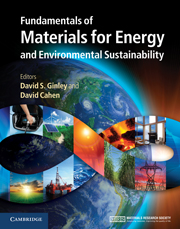Book contents
- Frontmatter
- Contents
- Contributors
- Preface
- Acknowledgments
- Part 1 Energy and the environment: the global landscape
- Part 2 Nonrenewable energy sources
- 9 Petroleum and natural gas
- 10 Advancing coal conversion technologies: materials challenges
- 11 Oil shale and tar sands
- 12 Unconventional energy sources: gas hydrates
- 13 Nuclear energy: current and future schemes
- 14 Nuclear non-proliferation
- 15 Nuclear-waste management and disposal
- 16 Material requirements for controlled nuclear fusion
- Part 3 Renewable energy sources
- Part 4 Transportation
- Part 5 Energy efficiency
- Part 6 Energy storage, high-penetration renewables, and grid stabilization
- Summary
- Appendix A Thermodynamics
- Appendix B Electrochemistry
- Appendix C Units
- Index
- References
15 - Nuclear-waste management and disposal
from Part 2 - Nonrenewable energy sources
Published online by Cambridge University Press: 05 June 2012
- Frontmatter
- Contents
- Contributors
- Preface
- Acknowledgments
- Part 1 Energy and the environment: the global landscape
- Part 2 Nonrenewable energy sources
- 9 Petroleum and natural gas
- 10 Advancing coal conversion technologies: materials challenges
- 11 Oil shale and tar sands
- 12 Unconventional energy sources: gas hydrates
- 13 Nuclear energy: current and future schemes
- 14 Nuclear non-proliferation
- 15 Nuclear-waste management and disposal
- 16 Material requirements for controlled nuclear fusion
- Part 3 Renewable energy sources
- Part 4 Transportation
- Part 5 Energy efficiency
- Part 6 Energy storage, high-penetration renewables, and grid stabilization
- Summary
- Appendix A Thermodynamics
- Appendix B Electrochemistry
- Appendix C Units
- Index
- References
Summary
Focus
The resurgence of nuclear power as an economical source of energy, plus as a strategy for reducing greenhouse-gas (GHG) emissions, has revived interest in the environmental impact of the nuclear fuel cycle. Just as GHG emissions are the main environmental impact of fossil-fuel combustion, the fate of nuclear waste determines whether nuclear power is viewed as an environmentally friendly source of energy. Not only must nuclear materials be designed that can operate under the extreme conditions within a reactor, but also new materials must be developed that can contain radionuclides for hundreds of thousands of years and prevent their release to the biosphere.
Synopsis
A variety of nuclear fuel cycles exists, each with its own types and volumes of nuclear waste [1]. An open nuclear fuel cycle envisions the direct geological disposal of the used nuclear fuel, mainly UO2. A closed fuel cycle uses chemical processing of the used fuel to reclaim fissile material, namely 235U and 239Pu, which is then fabricated into a new, mixed-oxide (MOX) fuel that provides additional power in a second cycle of irradiation and fission in a nuclear reactor. Only a limited number of cycles of reprocessing can be applied, because of changes in the nuclide composition of the used fuel; thus, MOX fuel eventually requires geological disposal as well. In addition, the chemical processing itself creates waste streams that consist mainly of fission-product elements that are highly radioactive (e.g., 137Cs) or have very long half-lives (e.g., 135Cs), as well as transuranium elements (e.g., 237Np) that form in the fuel as a result of neutron-capture and decay reactions. For all of these radionuclides, robust and extended isolation from the environment is required. More advanced “symbiotic” reprocessing technologies envision the separation of those radionuclides that can be transmuted in specially designed fast reactors (e.g., ones that utilize higher-energy neutrons to fission minor actinides, such as Np, Am, and Cm). Regardless of the type of fuel cycle envisioned, materials must be designed that can incorporate and isolate all residual radionuclides from the environment until they have decayed to safe levels of radioactivity. Nuclear-waste forms must be able to incorporate complex mixtures or individual radionuclides, survive the effects of radiation and self-heating caused by radioactive decay, and resist alteration and corrosion in a variety of geological environments over very long periods. The challenge for materials scientists is to design materials compatible with remote fabrication in high radiation fields. The response of these materials to radiation fields and to the geochemical and hydrological conditions in a geological repository must be well enough understood to project their performance over hundreds of thousands of years [2].
- Type
- Chapter
- Information
- Publisher: Cambridge University PressPrint publication year: 2011
References
- 1
- Cited by



